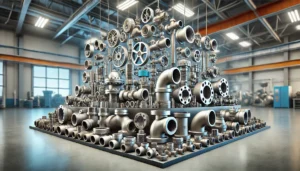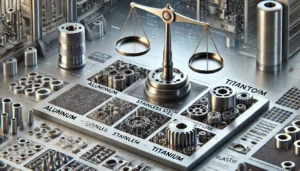It’s surprising that more than 60 percent of failures in industrial systems stem from improper selection or installation of pipe fittings. This remarkable statistic emphasizes the critical importance that pipe fitting possesses as the component at the epicenter of industrial activities. In the myriad of processes that make up an industry, be it oil and gas or water treatment, a single erroneous pipe fitting has the potential to bring entire systems to a standstill, resulting in downtimes that can cost millions.
These components are essential, and professionals like engineers and project managers know all too well the challenges that arise when dealing with their flawless performance. They try their best to prevent problems using a blend of material selection, pressure ratings, and environmental conditions along with their spatial thinking. We’ll attempt to understand the details regarding fittings, both practical and technical, that as essentials intersect in order to devise strategies to avert these problems. This isn’t simply about connecting pipes, it’s also about how choosing suitable pipe fittings can determine the success of vast industrial projects.
Understanding the Essentials of Pipe Fittings
Pipe fittings serve as the critical parts of a piping system that join two pipes to enable them to either change directions, change to a different size, or control the flow of a fluid. Similar to the way joints function in the human body, pipe fittings section piping into parts (bones) and enable the control of the flow of liquids or gases through the pipeline. The pipe can be constructed using several different materials and can fit many shapes as well as designs, each serving a distinct purpose and designed for a particular pressure. Choosing the appropriate fitting such as an elbow, tee, reducer, or valve, any of those depends on the system’s requirements like the fluid that is being transported, the temperature during operations, and the pressure to which it will be subjected.
Pipe fittings have many functions other than acting as connectors in an industry setting. They assist in complex systems by making sure operations run smoothly and safely. For example, in chemical plants, aggressive chemicals can be safely transported without leaking when the right fitting type is used. In water treatment plants, they are essential for the prevention of water contamination. In addition, resistant oil and gas fittings are necessary to cope with extreme pressure and contain the flow of materials. If these components are not working properly, entire systems will collapse and this will cause severe losses. Furthermore, there will be greater risks to safety and the ecosystem. Thus, knowing the basic principles of industrial systems is imperative. Understanding fittings goes beyond knowing parts, it requires grasping ecosystems.
Advanced Materials and Design Innovations in Pipe Fittings
New considerations in the materials that make up pipe fittings are revolutionizing how demanding requirements of different industries are managed. The developments in materials, advanced materials, and more specifically corrosion-resistant alloys, do serve an important function in places that traditional materials fail. Such alloys are categorized as having a combination of stainless steel and nickel and chrome. It is well known that the petroleum, maritime, chemical processing or oil and gas industries face tough competition. The corrosion these industries undergo results in rapid erosion of important fixtures. With these modern materials, there is greater longevity of fittings, less replacements are needed and maintenance costs are reduced.
Aside from corrosion-defending capabilities, other alloys are adapted for specific uses in other industries such as power generation or aerospace because of the high temperatures and pressure requirements. High-temperature alloys are of particular interest because they do retain their strength and stability under intense heat.
Pipe fittings require further design innovations and for good reason. One of them includes self-sealing designs which enhance fitting sealing effectiveness. Because of their ability to tighten further when internal pressure rises, gaps and leaks are virtually eliminated. This saves a lot of resources and helps in preventing dangerous situations especially in the oil and gas sector where leaking can be dangerous and costly.
Another notable advancement is the development of modular pipe fitting. These particular fittings are flexible and can be installed easily, allowing for quick construction or deconstruction. This design aids industries such as manufacturing and construction that require frequent system changes.
To conclude, the evolution of materials and design of pipe fittings marks great progress in addressing the sophisticated needs of industrial operations. Innovation of this magnitude not only improves efficiency along with safety but also enhances the durability and reliability of piping systems while situated in extreme conditions.
Troubleshooting and Maintenance Best Practices for Pipe Fittings
Maintenance best practices for all kinds of fittings begin with periodic care and attention. Adequate upkeep is necessary to maintain the quality of pipe fittings:
- Regular Inspection: Routine checks are essential. Look for signs of wear, corrosion, or damage, especially in fittings used in harsh environments or under high pressure. Early detection of issues can prevent major system failures.
- Cleaning and Lubrication: Fittings specifically those with moving mechanisms such as valves should be kept clean and lubricated. This not only prevents rust but also smooth movement.
- Correct Installation: According to maintenance best practices, after installation, check whether all fittings were put in place as directed. Failure to adhere to these instructions leads to mistakes such as changing the system’s pressure and enabling dangerous leaks predictive of system failure.
- Use of Proper Gaskets and Sealants: Use Correct Gaskets and Sealants: Ensuring no leaks occur, as in joints dealing with high-pressure liquids or gases, requires the proper gaskets and sealants for each fitting.
When troubleshooting common issues, here are some insights:
- Leaks: Leakage occurs due to loose connections, old gaskets, and corrosion, among other reasons. As with other fittings, make sure to tighten gaskets as needed and use less corroding materials.
- Blockages: Blockages are more common in systems dealing with solids or thicker fluids, so routine checks are a must. If any section of the piping is clogged, clean or replace the necessary parts.
- Pressure Fluctuations: Improper types or sizes of fittings can account for these issues. Always make sure the fittings used do not go beyond the pressure thresholds of the system.
Remember, the best approach to maintenance and troubleshooting is knowing the precise challenges and requirements needed in your system. With pipes and fittings, the correct care and IP attention can greatly reduce downtime and improve longevity.
Exciting innovations are underway for the future of pipe fitting technology. One major focus of change is the creation of ‘smart’ pipe fittings. These sophisticated fittings utilize technology that contains sensors and can connect, enabling them to monitor a system’s pressure, flow rates, and even detect early leaks. This technological wonder heralds the advancement of industrial piping systems with regard to efficiency and safety by minimizing the chances of failures and facilitating maintenance.
In addition, the use of more sustainable materials as fittings is also promising while qualifying the standard of environmental responsibility. These materials ‘sustainer’ are not only eco-friendly, but also aid in enhanced performance, efficiency, and durability.
Conclusion
As observed, there is a numerous selection and maintenance of fittings one can choose from. All of which requires attentive care since they influence the operational effectiveness and safety of industrial activities. Knowing the classification, make, and suitable methods relative to fittings is bound to affect the functionality and dependability of any system in an industry.
Check out our next post “Choosing Quality Over Cost: The Long-Term Benefits of Investing in High-Quality Pipe Fittings” where we will discuss how thoughtfully purchasing pipe fittings can save money over time and improve system performance and operational excellence. This analysis of why quality matters in pipe fittings will be very informative, so don’t miss it!










